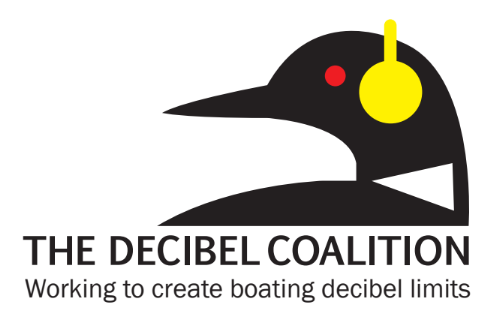
FOCA first wrote about noise pollution in our 2009 publication, Take the Plunge. We continue to hear from members who are concerned about excessive noise in cottage country.

The more we understand about the noise we make, and how it travels over water, the better neighbours we can be at our waterfront properties!

In early 2022 Transport Canada (TC) launched a “Let’s Talk” web portal to collect public comments about possible changes to small vessel (boat) noise emissions.
In April 2023, they released “What we heard: Small vessel noise emissions” – a report on public responses to a variety of proposed options to address the issue of noise from pleasure craft engines.

The Decibel Coalition is a project of Safe Quiet Lakes, and members include cottage associations, environmental groups and municipalities. See their online resources: How do I know if my boat is too noisy?
Since 2019, the Decibel Coalition has been working to address growing concerns about excessively loud boats. This national Coalition has been lobbying TC to enhance existing Small Vessel Regulations to include decibel limits on boat motor noise, as many other jurisdictions around the world have done.
Excerpts from the article “Noise around the Lake” by Andy Metelka in FOCA’s publication, Take the Plunge (2009):
Some of the most enjoyable aspects of cottage country are associated with sound, whether it be the haunting cry of the loon or the gentle lapping of waves onto the shore. Quiet mornings spent on the dock, or a night searching for stars are treasured memories that stay with us during the cold winter months. However, as cottage-country population increases these moments might become rare as noise levels also increase.
About How Sound Behaves at Night & Along the Water:
In very general terms, sound waves are pulled in the direction of fastest travel velocity. Sound also travels faster in warm air. On a warm summer day at the lake, sound waves from cottage activities travel in a more upward direction toward warm air, and not as much sound pressure reaches our ears at the shore. At dusk, the water surface cools, producing a warm air layer between the water and the sky (thermal inversion). Those same sound waves follow the warm air again; sound pressure is concentrated along the surface of the lake, and we can hear even the quiet conversation in a passing canoe. Normally sound pressure (as measured by a sound level metre) dissipates at the rate of six decibels (dB) every time the distance doubles. This rate of loss decreases during temperature gradient conditions at night, especially when the temperature variant is high during dusk.
Loons and other animals use this time period to communicate over great distances because of this property of sound.
Other contributing effects such as reflective rocky shorelines, wind speed, and direction can affect noise transmissions as well. These vectors all combine at times, which compounds the problem. Some online resources* that describe this phenomenon:
- A Guide to Noise Control in Minnesota
- Kettering University Acoustics Research – images of sound refraction
… Continuous noise from motorized vehicles, boats, ATVs, and construction is on the increase in cottage country and is difficult to regulate. The Canadian government has established noise bylaws that are constantly under review. Federal noise guidelines can be reviewed online. The Ontario Ministry of the Environment covers noise under the Environment Protection Act. The Ministry categorizes noise as a contaminant form of air pollution. Information is posted here. Rural area levels may not be as strictly defined; this includes cottage country.
(* NOTE: these are all new links to related information, as the 2009 article links no longer resolve to accessible resources)
